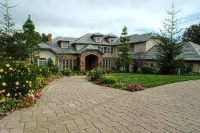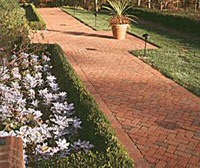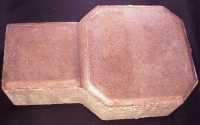
Driveway Pavers - Concrete & Clay
For the thinner and more absorbent type of tile that isalso called "pavers", see our page on unglazed tiles.
How to:
Seal | Clean | Repair | Protect
Strip & Restore | Easy Care



Concrete Pavers .................. Clay Pavers


. Extremely tough and durable. Used in Europe for decades in high volume commercial parking areas.
. Sand joints and bed allow for easy removal for design modifications or subsurface repair work.
. The sand bed and joint method saves money over concrete bed and joint.
. Great variety of colors and shapes allow for a wide spectrum of creative design. Also available in a "tumbled" type that is more antiqued and has rounded edges.
Pavers can sometimes arrive with efflorescence (white powder stains), transit scuffing, vibration scuffing, or acquire these later. See this page for restoration tips.
About sand stabilizers and white smears or spots on pavers:
Sometimes a paver installation might have a "sand stabilizer" mixed in with the sand. These are basically a glue type powder and can use terms like "polymeric" or "poly..." something, or some other descriptive word.
Many times this powder ends up on the face of the pavers, then during the wetting process to liquify the glue in the sand, it is also liquified on the pavers resulting is white spots or smears. Or, another cause is a little of the glue washing out during the wetting process and leaving the light colored smears on the pavers.This residue needs to be removed before sealing. Usually, lacquer thinner will dissolve this glue and allow it to be wiped off. If not, test a sealer stripper to clean the glue off. This issue can be avoided because a petroleum solvent based acrylic sealer can also glue together the sand particles in the single step of sealing.
Your Choices for Sealing
This surface (driveway rated pavers) is dense and low absorption. Water base penetrating sealers have a difficult time penetrating down. Solvent base penetrating sealers may require being sprayed to achieve a smooth finish.
Our suggestions to test are:- Penetrating petroleum solvent formulas with acrylic solids. These can be sprayed to finish nicely, but solids level might need to be adjusted if manufacturer allows dilution.
- Water based film forming that can flow out and self-level.
- Water based penetrating that is usually invisible when dry.
- Click here to see What effects you can expect from each sealer type.
- Click here to see our suggested sealers, cleaners, and application tools.
Some questions you may not be thinking to ask right now that could become important:
. Was it sealed in the past? Does that matter?
. Will a new sealer be compatible with whatever was used before?
. What sealer will give the visual results you want?
. Will you also be able to have a sealer solve problem(s)? ( Answer: yes. Just know which to pick.)
Items of Interest
How to select a sealer
A sealer can do far more than just bead water and look pretty! To see what that is click here.
Important: If your project has had any sealer applied in the past, it must be evaluated differently. To see why, Click here!
Sealer "solids" levels?
A porous surface will require more gallons (more money) of a lower solids sealer than using a higher solids level sealer. That, plus different surfaces have different requirements. It is only a matter of which is best for your needs.
The more porous the surface, the more solids will be required to achieve the desired effects of gloss, strengthening, stopping efflorescence, etc.
The more porous the surface, generally the greater the need for the sealer to create a stronger surface.
An old sealer below the surface, even after stripping, will lower the absorption and porosity to some degree. Sometimes it is uneven below the surface and can create an uneven coloring effect with a color enhancing sealer applied later. Another reason to test first.
Do not believe yet that you have the type of surfacing you were told:
Colors fading?
Renew a glossy finish
Re: "penetrating sealers": do not apply thin layer upon thin layer. Apply a sufficient quantity to insure below surface penetration & bonding. A layer of sealer on top of another layer of sealer can result in poor bonding between layers and that can cause separation peeling that looks grayish.
Concerned about Doing It Yourself or what your contractor says?
If you are concerned about doing it yourself - consider that the satisfaction of a project is directly related to YOUR knowledge of what needs to be done and how. Who actually does the work is less important.
The goal for contractors is - NO CALL BACKS. A good contractor will understand the logic of not taking shortcuts.
©
The goal for contractors is - NO CALL BACKS. A good contractor will understand the logic of not taking shortcuts.